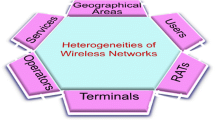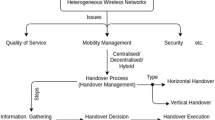Abstract
By the newly emerging radio access technologies, we face the new heterogeneous network environment. Focusing on the co-existence of multiple access networks and the complex service combinations, the wireless service operators should guarantee good quality of services for every user. Thus, the service operators build a new operation framework which combines the existing networks and newly adopted ones. Our objective is finding the optimal heterogeneous network operation framework. We suggest the market-based marginal cost function for evaluating the relative value of resources for each network and develop a whole new heterogeneous network operation framework. To prove the applicability of the proposed operation framework, we build a large-scale JAVA simulator. We can easily test the various service scenarios in heterogeneous network environment by the simulator.









Similar content being viewed by others
References
Prytz, M., Karlsson, P., Cedervall, C., Bria, A., Karla, I.: Infrastructure cost benefits of ambient networks multi-radio access. In: Proc. IEEE Vehicular Technology Conference (2006)
Pittmann, F., et al.: Ambient networking: concept & architecture. Inform. Soc. Technol. (2005)
Sigle, R., et al.: Multiple radio access architecture. Inform. Soc. Technol. (2005)
Niedermeier, C., Schmid, R., Mohyeldin, E., Dillinger, M.: Handover Management and Strategies for Reconfigurable Terminals (SDR Forum Contribution, 2002)
Haykin, S.: Cognitive radio: brain-empowered wireless communications. IEEE J. Sel. Area Commun. 23(2), 201–220 (2005)
van Sinderen, M.J., van Halteren, A.T., Wegdam, M., Meeuwissen, H.B., Eertink, E.H.: Supporting context-aware mobile applications: an infrastructure approach. IEEE Commun. Mag. 44(9), 96–104 (2006)
van Kranenburg, H., Bargh, M.S., Iacob, S., Peddemors, A.: A context management framework for supporting context-aware distributed applications. IEEE Commun. Mag. 44(9), 67–74 (2006)
Fodor, G., Eriksson, A., Tuoriniemi, A.: Providing quality of service in always best connected networks. IEEE Commun. Mag. 41(7), 154–163 (2003)
Gazis, V., Alonistioti, N., Merakos, L.: Toward a generic always best connected capability in integrated WLAN/UMTS cellular mobile networks (and beyond). IEEE Wireless Commun. 12(3), 20–29 (2005)
Gustafsson, E., Jonsson, A.: Always best connected. IEEE Wireless Commun. 10(1), 49–55 (2003)
Gazis, V., Houssos, N., Alonistioti, N., Merakos, L.: On the complexity of always best connected in 4G mobile networks. IEEE 58th Veh. Technol. Conf. 4, 2312–2316 (2003)
Clark, D., Partridge, C., Ramming, Ch.s., Wroclawski, J.: A Knowledge Plane for the Internet. ACM Sigcomm 2003, Karlsruhe, Germany (Aug. 2003)
Crowcroft, J., Hand, S., Mortier, R., Roscoe, T., Warfield, A.: Plutarch: an argument for network pluralism. In: Proc. ACM Sigcomm FDNA 2003 Workshop, Karlsruhe, Germany (Aug. 2003)
Sollins, K.R.: Designing for scale and differentiation. In: Proc. ACM Sigcomm FDNA 2003 Workshop, Karlsruhe, Germany (Aug. 2003)
3GPP TR 25.881 Improvement of Radio Resource Management (RRM) across RNS and RNS/BSS
3GPP TR 25.891 Improvement of Radio Resource Management (RRM) across RNS and RNS/BSS post-Rel-5
3GPP TR22.934 Feasibility study on 3GPP - WLAN interworking
3GPP TR23.234 3GPP - WLAN interworking; System description
3GPP TR23.934 3GPP - WLAN interworking; Functional and architectural definition
Buddhikot, M., et al.: Design and Implementation of a WLAN/CDMA2000 Interworking Architecture. IEEE Commun. Mag. 41(11), 90–100 (2003)
EU IST 5FP Project ARROWS, Advanced Radio Resource Management for Wireless Services, http://www.arrows-ist.upc.es
EU IST 5FP Project MonaSidre, Management Of Networks And Services In a Diversified Radio Environment, http://www.monasidre.com
EU IST 5FP Project CAUTION++, Capacity and network management platform for increased utilisation of wireless systems of next generation, http://www.telecom.ece.ntua.gr/CautionPlus
EU IST 6FP Project EVEREST, Evolutionary Strategies for Radio Resource Management in Cellular Heterogeneous Networks, http://www.everest-ist.upc.es/
Luo, J., Mukerjee, R., Dillinger, M., Mohyeldin, E., Schulz, E.: Investigation of radio resource scheduling in WLANs coupled with 3G cellular network. IEEE Commun. Mag. 41(6), 108–115 (2003)
Vanem, E., Svaet, S., Paint, F.: Effects of multiple access alternatives in heterogeneous wireless networks. Proc. IEEE WCNC 2003 3, 1696–1700 (2003)
Koo, I., Furuskar, A., Zander, J., Kim, K.: Erlang capacity of multiaccess systems with service-based access selection. IEEE Commun. Lett. 8(11), 662–664 (2004)
3GPP TR22.951 Network Sharing; Service Aspects and Requirements (Release 6)
3GPP TR23.851 Network Sharing; Architecture and Functional Description (Release 6)
Author information
Authors and Affiliations
Corresponding author
Appendix A
Appendix A
To prove the difference among marginal costs is converged to zero. We first set up a system of non-linear differential equations according to Traffic Transition Law as follows:
For a transition rate λ,
Let \( A_{ij} : = c_{ij} (f_{i} (u_{i} ) - f_{j} (u_{j} )). \) The total traffic \( u_{1} + u_{2} + \cdots + u_{N} \) is conserved since
We measure the “variation among marginal costs” with the following function: \( V(t) = \sum\limits_{i,j} {c_{ij} (f_{i} (u_{i} (t)) - f_{j} (u_{j} (t)))^{2} }. \) The load balancing effect by the marginal cost function can be shown by the \( V(t) = \sum\limits_{i,j} {c_{ij} (f_{i} (u_{i} (t)) - f_{j} (u_{j} (t)))^{2} } \to 0 \) as the dynamics as described by the marginal cost based traffic transition. Using the fact that \( A_{ij} = - A_{ji} , \) we have
The minimum of V is 0, when \( f_{1} \left( {u_{1} } \right) = f_{2} \left( {u_{2} } \right) = \cdots = f_{N} \left( {u_{N} } \right). \) Therefore, we prove the zero convergence of difference among the marginal cost.
Rights and permissions
About this article
Cite this article
Kim, JH. Design of Common Resource Management and Network Simulator in Heterogeneous Radio Access Network Environment. J Netw Syst Manage 17, 137–156 (2009). https://doi.org/10.1007/s10922-008-9104-2
Published:
Issue Date:
DOI: https://doi.org/10.1007/s10922-008-9104-2




